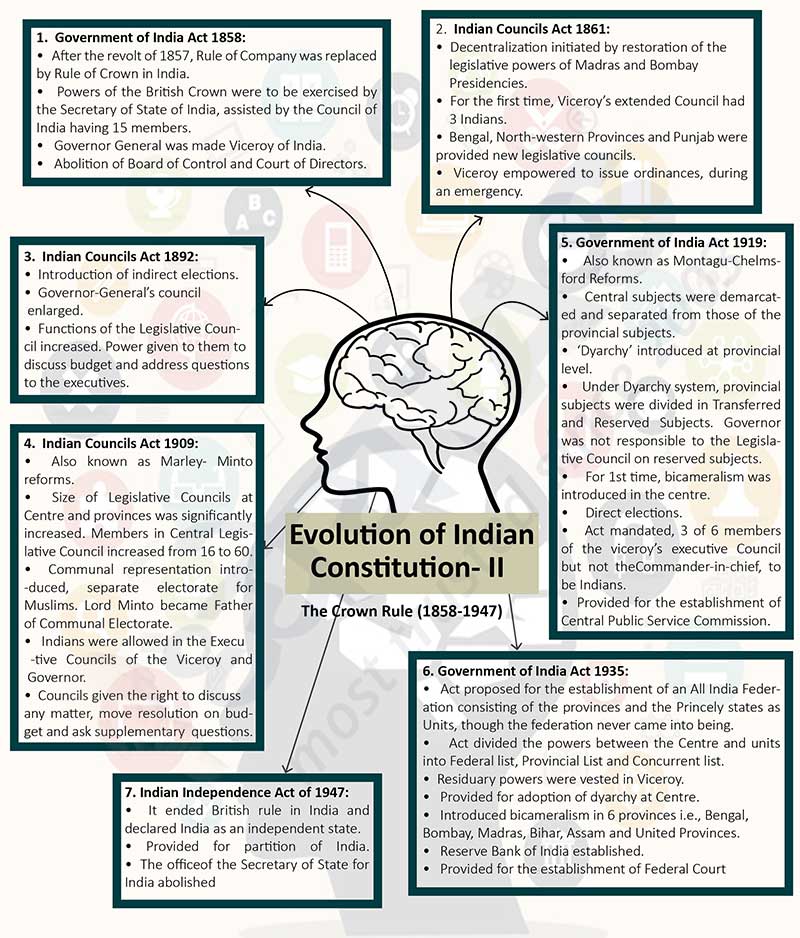Brain-booster /
26 Nov 2021
Brain Booster for UPSC & State PCS Examination (Topic: Evolution of Indian Constitution Part - II (The Crown Rule 1858-1947)

Government of India Act 1858:
- After the revolt of 1857, Rule of Company was replaced by Rule of Crown
in India.
- Powers of the British Crown were to be exercised by the Secretary of
State of India, assisted by the Council of India having 15 members.
- Governor General was made Viceroy of India.
- Abolition of Board of Control and Court of Directors.
Indian Councils Act 1861:
- Decentralization initiated by restoration of the legislative powers of
Madras and Bombay Presidencies.
- For the first time, Viceroy’s extended Council had 3 Indians.
- Bengal, North-western Provinces and Punjab were provided new legislative
councils.
- Viceroy empowered to issue ordinances, during an emergency.
Indian Councils Act 1892:
- Introduction of indirect elections.
- Governor-General’s council enlarged.
- Functions of the Legislative Council increased. Power given to them to
discuss budget and address questions to the executives.
Indian Councils Act 1909:
- Also known as Marley- Minto reforms.
- Size of Legislative Councils at Centre and provinces was significantly
increased. Members in Central Legislative Council increased from 16 to 60.
- Communal representation introduced, separate electorate for Muslims.
Lord Minto became Father of Communal Electorate.
- Indians were allowed in the Executive Councils of the Viceroy and
Governor.
- Councils given the right to discuss any matter, move resolution on
budget and ask supplementary questions.
Government of India Act 1919:
- Also known as Montagu-Chelmsford Reforms.
- Central subjects were demarcated and separated from those of the
provincial subjects.
- ‘Dyarchy’ introduced at provincial level.
- Under Dyarchy system, provincial subjects were divided in Transferred
and Reserved Subjects. Governor was not responsible to the Legislative
Council on reserved subjects.
- For 1st time, bicameralism was introduced in the centre.
- Direct elections.
- Act mandated, 3 of 6 members of the viceroy’s executive Council but not
theCommander-in-chief, to be Indians.
- Provided for the establishment of Central Public Service Commission.
Government of India Act 1935:
- Act proposed for the establishment of an All India Federation consisting
of the provinces and the Princely states as Units, though the federation
never came into being.
- Act divided the powers between the Centre and units into Federal list,
Provincial List and Concurrent list.
- Residuary powers were vested in Viceroy.
- Provided for adoption of dyarchy at Centre.
- Introduced bicameralism in 6 provinces i.e., Bengal, Bombay, Madras,
Bihar, Assam and United Provinces.
- Reserve Bank of India established.
- Provided for the establishment of Federal Court
Indian Independence Act of 1947:
- It ended British rule in India and declared India as an independent
state.
- Provided for partition of India.
- The office of the Secretary of State for India abolished









